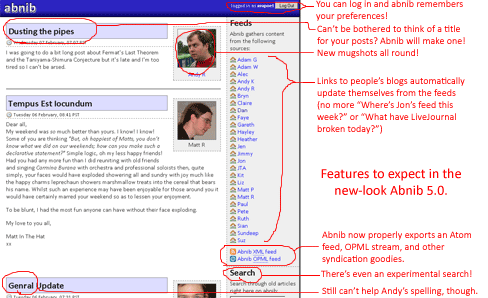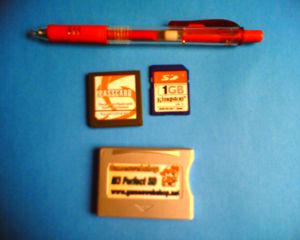This post starts very geeky, but becomes about computer games later on. Feel free to scroll down three paragraphs if you like computer games but don’t like computer hardware
hacking.
My M3 Perfect and some related hardware arrived today. Basically, it’s a SD card
reader that plugs into a Game Boy Advance slot (which are found on not only the Game Boy Advance series but also the Nintendo DS). By itself, it allows a Nintendo DS (or a DS Lite, as
my new toy is) to play music, videos, etc. But combined with an Passcard (also arrived this morning), it allows backup games and homebrew software to be easily loaded onto the device.
Within minutes, I had DSLinux, a Linux distribution for the Nintendo DS, working. It felt immensely cool to be typing at a Bash shell using my DS stylus. I couldn’t get the wireless internet connection working, though – the drivers kept failing to load, which is
probably either a result of (a) the DS Lite possibly having different firmware for interfacing with the network subsystem or (b) the M3 Perfect I got is the SD card edition, rather than
the CF edition, which is better supported by DSLinux. I chose the SD card edition despite it being a few pounds more expensive
because it’s slightly smaller (and therefore doesn’t stick out of the side of my handheld in such an unslightly way as the CF one would have) and because I can potentially fit more onto
a SD card (although the only SD card I own is 1Gb, the same size as the largest CF card the M3 can take). In any case, both possibilities sound equally unlikely: further investigation
will ensure.
The ultimate aim of this little project is to get a graphical VNC client for the DS (take a look at
that screenshot!) running, or some other remote control, so I can take full control of my desktop PC,
wirelessly, from, like, my bed. Or from the couch. Or from and wireless internet hotspot anywhere that somebody hasn’t secured properly. Toy.
But the other benefit of this little purchase is the ability to, how shall we say, “try before I buy” Nintendo DS games. I’ve spent quite some time today playing the stunning Trauma Center: Under The Knife. It hasn’t been since Half-Life 2
that I’ve played a computer game that genuinely made me jump with fright.
This isn’t Theme Hospital. This is Life and Death (for those of you
too young to remember, this was a stunning late-80s “Sim Surgeon”). Starting as a junior surgeon, you’ll remove benign tumours, treat laceration injuries, and laser off polyps.
The whole things starts with a very “hold your hand” approach, but the learning curve is steep. Within 25 minutes of play you’ll be performing surgery within the chest cavity of car
crash victims when something goes wrong (their heart stops, or their symptoms severely exacerbate, or it turns out there’s something more seriously wrong with them) and you’ve got
nobody there to help you: you have to work alone.
It’s dark and cold and hard. Very hard. I struggled to keep up with the pace and had to re-attempt some of the levels (such as the brutal on early in the second chapter in which I had
to remove aneurisms from the arteries of the intestines, and they just kept exploding on me, showering blood everywhere and destabilising the patient’s condition) several times.
Nonetheless, I had great fun watching Claire replay those levels, on the edge of my seat whenever I knew something was about to go terribly
wrong. Contrary to the image Nintendo sometimes convey: this is not a game for kids.
Another game I’ve enjoyed trying out is Mario & Luigi: Partners In Time, which plays a lot like Paper Mario: The Thousand-Year Door, but with semi-independent simultaneous control over up to four (Mario, Luigi,
Mario’s younger self, Luigi’s younger self) different characters. Yes, at the same time. Yes, that fucks with your head. Quite quickly.
Then there’s Super Princess Peach, a platform game in which Peach uses the power of mood swings (I kid you not – she
fluctuates between singing, crying, and breathing fire, just like a real woman) in order to get her way. And Super Monkey Ball Touch & Roll, more stupid puzzle game fun…
It’s not all piracy (although at least a little bit ethically – we’ll buy legitimate copies of the good stuff, almost certainly including Trauma Center) of stuff I could have
bought at my local Game: I’ve also had a great deal of fun with Electroplankton, for which a release outside of Japan is still
promised, but sadly absent. Electroplankton is a software toy in the truest sense of the word. The player manipulates the movement of musical plankton in order to generate what can just
about be described as music. I came home and hooked it up to the stereo and Claire and I had great fun for some time, playing with the different plankton and trying to discover how they
all “worked”. And I’m also looking forward to giving some of the Naruto games (which’ll probably never
be released outside of Japan) a go.




